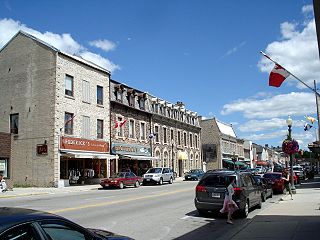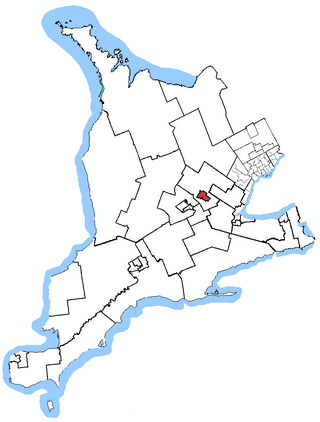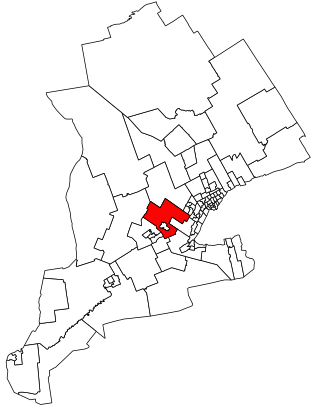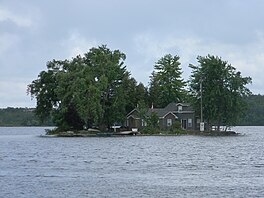
Guelph is a city in Southwestern Ontario, Canada. Known as The Royal City, it is roughly 22 km (14 mi) east of Kitchener and 70 km (43 mi) west of Downtown Toronto, at the intersection of Highway 6, Highway 7 and Wellington County Road 124. It is the seat of Wellington County, but is politically independent of it.

Erin is a town in Wellington County, approximately 80 kilometres (50 mi) northwest of Toronto, Ontario, Canada. Erin is bordered by the Town of Caledon, Ontario to the east, the Town of Halton Hills to the south, the Township of Guelph/Eramosa to the west and the Township of East Garafraxa to the north.

Wellington County is a county located in Southwestern Ontario, Canada and is part of the Greater Golden Horseshoe. The county, made up of two towns and five townships, is predominantly rural in nature. However many of the residents in the southern part of the county commute to urban areas such as Guelph, Kitchener, Waterloo, Brampton, Mississauga, Toronto and Hamilton for employment. The northern part of the county is made up of mainly rural farming communities, except for a few larger towns such as Mount Forest and Arthur. According to the 2021 census, the population of the county was 241,026.

Puslinch is a township in south-central Ontario, Canada, in Wellington County, surrounding the south end of Guelph. The main source of production is agricultural, spring water bottling and mining. Aggregate mining has been dominant throughout the county. About half of the township is forested, and a conservation area lies to the southwest. Near the western edge of the township, just outside Cambridge, Ontario, is Puslinch Lake, the largest kettle lake in North America. It is part of the Guelph census metropolitan area.

The Township of Georgian Bay is an area municipality of the District Municipality of Muskoka, in south-central Ontario, Canada. It is located on the Severn River, where it empties into the eponymous Georgian Bay. The municipal offices are at Port Severn.
King's Highway 6, commonly referred to as Highway 6, is a provincially maintained highway in the Canadian province of Ontario. It crosses a distance of 480 km (300 mi) between Port Dover, on the northern shore of Lake Erie, and Espanola, on the northern shore of Lake Huron, before ending at the Trans-Canada Highway (Highway 17) in McKerrow.

Southampton is a community on the shores of Lake Huron in Bruce County, Ontario, Canada. It is close to Port Elgin and is located at the mouth of the Saugeen River in the Saugeen Ojibway Nation Territory. The size of the town is 6.44 square kilometres. The permanent population in 2016 was 3,678, but the summer population is higher since cottagers and campers spend vacation time in the area.

Region of Waterloo International Airport or Kitchener/Waterloo Airport is an international airport serving the Regional Municipality of Waterloo in Woolwich, Ontario, Canada, west of Toronto. It has year round daily flights to Edmonton, Vancouver, Victoria, Winnipeg, Calgary, Orlando, Halifax, Fort Lauderdale and Kelowna through Flair Airlines and WestJet. It also has seasonal flights to Cancun through Sunwing Airlines and Flair Airlines. In 2022, the airport ranked seventh-busiest in Canada by total aircraft movements and twentieth-busiest by passenger traffic.

Southwestern Ontario is a secondary region of Southern Ontario in the Canadian province of Ontario. It occupies most of the Ontario Peninsula bounded by Lake Huron, including Georgian Bay, to the north and northwest; the St. Clair River, Lake St. Clair, and Detroit River, to the west; and Lake Erie to the south. To the east, on land, Southwestern Ontario is bounded by Central Ontario and the Golden Horseshoe.

The Eramosa River is a river in Wellington County in southwestern Ontario which rises near Erin, Ontario, and flows southwest through the city of Guelph, where it joins the Speed River, which then enters the Grand River in Cambridge. The river is believed to derive its name from the Mississauga word um-ne-mo-sah, meaning "black dog" or "dead dog".

Guelph is a federal electoral district in Ontario, Canada, that has been represented in the House of Commons of Canada since 1979. This riding has had a Liberal MP since 1993.

Wellington—Halton Hills is a federal electoral district in Ontario, Canada, that has been represented in the House of Commons of Canada since 2004.
Wellington South was a Canadian federal electoral district represented in the House of Commons of Canada from 1867 to 1968. It was located in the province of Ontario. It was created by the British North America Act of 1867 as the "South Riding of the county of Wellington". The County of Wellington was divided into three ridings: the North, South and Centre Ridings".

The Guelph Transit Commission is a small public transportation agency that operates transit bus services in Guelph, Ontario, Canada. Established in 1929 after the closure of the Guelph Radial Railway Company streetcar lines, Guelph Transit has grown to comprise over 70 buses serving 28 transit routes.

Salem is a compact rural community and unincorporated place in the incorporated township of Centre Wellington, Wellington County, in southwestern Ontario, Canada.

The Wellington District was a historic district in Upper Canada and its successor, Canada West, which existed until 1849. It was formed in June 1840 from townships transferred from certain other districts:

Wellington—Halton Hills is a provincial electoral district in western Ontario, Canada. It elects one member to the Legislative Assembly of Ontario.

Huron-Kinloss is a township in the Canadian province of Ontario, located within Bruce County. The township had a population of 7,069 in the Canada 2016 Census.

Allan's Mill was a watermill located on both banks of the Speed River in Guelph, Ontario, Canada. Part of the site is now listed under the Ontario Heritage Act.


















